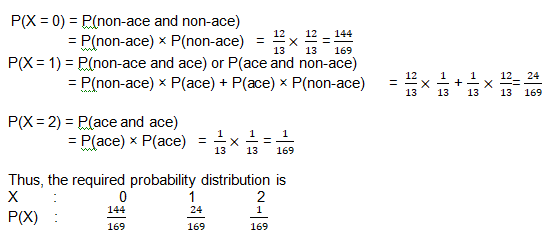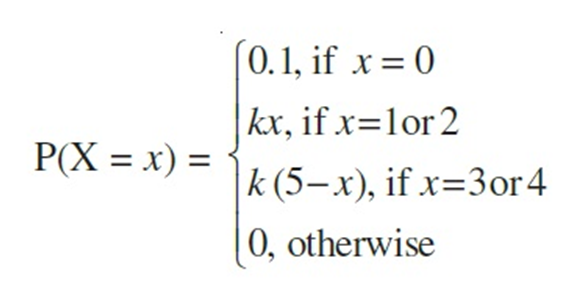- Books Name
- Mathmatics Book Based on NCERT
- Publication
- KRISHNA PUBLICATIONS
- Course
- CBSE Class 12
- Subject
- Mathmatics
Random Variables and its Probability Distributions
Random Variables:
Definition : A random variable is a real valued function whose domain is the sample space of a random experiment.
Example: let us consider the experiment of tossing a coin two times in succession.
The sample space of the experiment is S = {HH, HT, TH, TT}.
If X denotes the number of heads obtained, then X is a random variable and for each outcome, its value is as given below :
X(HH) = 2, X (HT) = 1, X (TH) = 1, X (TT) = 0.
That means X= 0 1 2
Example : A person plays a game of tossing a coin thrice. For each head, he is given Rs 2 by the organizer of the game and for each tail, he has to give Rs 1.50 to the organiser. Let X denote the amount gained or lost by the person. Show that X is a random variable and exhibit it as a function on the sample space of the experiment.
Solution: X is a number whose values are defined on the outcomes of a random experiment. Therefore, X is a random variable.
Now, sample space of the experiment is
S = {HHH, HHT, HTH, THH, HTT, THT, TTH, TTT}
Then X(HHH) = Rs (2 × 3) = Rs 6
X(HHT) = X(HTH) = X(THH) = Rs (2 × 2 −1 × 1.50) = Rs 2.50
X(HTT) = X(THT) = (TTH) = Rs (1 × 2) – (2 × 1.50) = – Re 1
and X(TTT) = Rs (3 × 1.50) =-Rs 4.50
minus means loss and plus means gain.
X= {– 1, 2.50, – 4.50, 6}
Probability Distribution of the random variable X
Definition : The probability distribution of a random variable X is the system of numbers
X : x1 x2 x3 ... xn
P(X) : p(x1) p(x2) p(x3)... p(xn)
![]()
Example : Two cards are drawn successively with replacement from a well-shuffled deck of 52 cards. Find the probability distribution of the number of aces.
Solution: The number of aces is a random variable. Let it be denoted by X. Clearly, X can take the values 0, 1, or 2.
Now, since the draws are done with replacement, therefore, the two draws form independent experiments.
P(ace)= 4/52 = 1 / 13
P(non ace)= 48/52 = 12 / 13
Therefore,

Example : Let X denote the number of hours you study during a randomly selected school day. The probability that X can take the values x, has the following form, where k is some unknown constant.

(a) Find the value of k.
(b) What is the probability that you study at least two hours ?
Exactly two hours?
At most two hours?
Solution: The probability distribution of X is
X: 0 1 2 3 4
P(X) 0.1 k 2k 2k k
(a) We know that

=> 0.1 + k + 2k + 2k + k = 1
=> k = 0.15
(b) P(you study at least two hours) = P(X ³2)
= P(X = 2) + P (X = 3) + P (X = 4)
= 2k + 2k + k = 5k = 5 × 0.15 = 0.75
P(you study exactly two hours) = P(X = 2)
= 2k = 2 × 0.15 = 0.3
P(you study at most two hours) = P(X £2)
= P (X = 0) + P(X = 1) + P(X = 2)
= 0.1 + k + 2k = 0.1 + 3k = 0.1 + 3 × 0.15
= 0.55

 KRISHNA PUBLICATIONS
KRISHNA PUBLICATIONS
